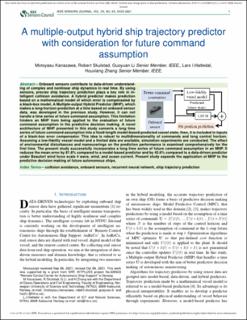| dc.contributor.author | Kanazawa, Motoyasu | |
| dc.contributor.author | Skulstad, Robert | |
| dc.contributor.author | Li, Guoyuan | |
| dc.contributor.author | Hatledal, Lars Ivar | |
| dc.contributor.author | Zhang, Houxiang | |
| dc.date.accessioned | 2021-11-03T13:03:00Z | |
| dc.date.available | 2021-11-03T13:03:00Z | |
| dc.date.created | 2021-10-10T21:58:18Z | |
| dc.date.issued | 2021 | |
| dc.identifier.issn | 1530-437X | |
| dc.identifier.uri | https://hdl.handle.net/11250/2827631 | |
| dc.description.abstract | Onboard sensors contribute to data-driven understanding of complex and nonlinear ship dynamics in real time. By using sensors, precise ship trajectory prediction plays a key role in intelligent collision avoidance. A hybrid predictor makes prediction based on a mathematical model of which error is compensated by a black-box model. A Multiple-output Hybrid Predictor (MHP), which makes a long-horizon prediction at a time based on onboard sensor data, was developed in the previous study. However, it can not handle a time series of future command assumption. This limitation hinders an MHP from being applied to the evaluation of future command assumption in the predictive decision making. A novel architecture of MHP presented in this study converts a long time series of future command assumption into a fixed-length model-based-predicted vessel state; then, it is included in inputs of a black-box error compensator. This idea is robust to multidimensionality of commands and long control horizon. Assuming a low-fidelity vessel model and a limited data are available, simulation experiments are conducted. The effect of environmental disturbances and maneuverings on the prediction performance is examined comprehensively for the first time. The present study successfully incorporates a long time series of future command assumption in an MHP. It reduces the mean error by 81.8% compared to a model-based predictor and by 45.6% compared to a data-driven predictor under Beaufort wind force scale 4 wave, wind, and ocean current. Present study expands the application of MHP to the predictive decision making of future autonomous ships. | en_US |
| dc.language.iso | eng | en_US |
| dc.publisher | Institute of Electrical and Electronics Engineers (IEEE) | en_US |
| dc.title | A multiple-output hybrid ship trajectory predictor with consideration for future command assumption | en_US |
| dc.type | Peer reviewed | en_US |
| dc.type | Journal article | en_US |
| dc.description.version | acceptedVersion | en_US |
| dc.rights.holder | © IEEE. Personal use of this material is permitted. Permission from IEEE must be obtained for all other uses, in any current or future media, including reprinting/republishing this material for advertising or promotional purposes, creating new collective works, for resale or redistribution to servers or lists, or reuse of any copyrighted component of this work in other works. | en_US |
| dc.source.journal | IEEE Sensors Journal | en_US |
| dc.identifier.doi | 10.1109/JSEN.2021.3119069 | |
| dc.identifier.cristin | 1944731 | |
| dc.relation.project | Norges forskningsråd: 309323 | en_US |
| cristin.ispublished | true | |
| cristin.fulltext | postprint | |
| cristin.qualitycode | 2 | |
